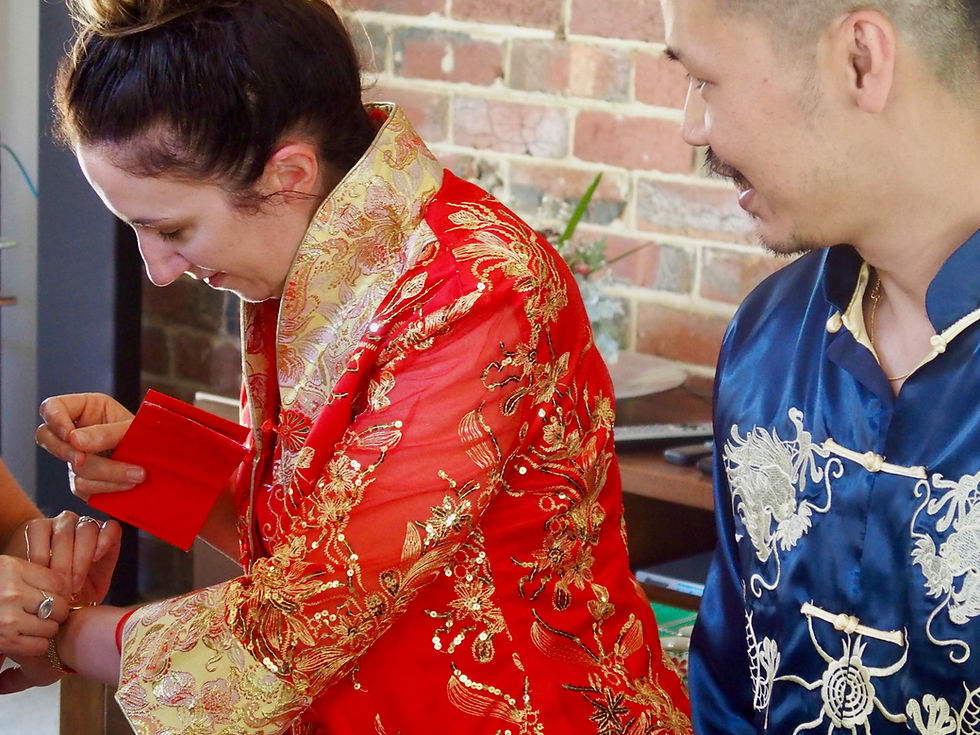A Chinese wedding tea ceremony
- rosemarydearman1
- Feb 26, 2019
- 3 min read

"Both bride and groom are expected to serve tea in a gaiwan to both sides of the parents, representing an important moment in which members of both families become relatives of each other." Teasenz
I should have done this post before the wedding post, because this event happened the day before the wedding. I'm not really sure who decided that this event should take place - possibly the bride, possibly the groom's mother may have expressed a wish for one. But whoever decided, it was enthusiastically embraced by both families. Indeed the groom's lovely mother said that she had been very touched by the whole thing as her daughter had not had one.
I believe it is called cha dao - which means the way of tea. It dates back to the Tang dynasty over 1200 years ago and was taken to Japan where the Japanese have made it much more formal. It's purpose is to show respect to the older generation.
"It is a significant way to show respect. In a wedding, such an act is to show respect and gratitude to parents for all the years of love and care." Teasenz
In our case it was very much a family affair - just the immediate relatives, and the only participants were the bride and groom, the groom's sister who managed the tea, and all the oldies who included us and the groom's aunt. The brothers and sisters, and families looked on. The bride and groom were dressed in traditional clothes, and the groom's mother too, and I have to say that the bride's dress and jacket were just beautiful. The groom's jacket was pretty impressive too. I forgot to ask if blue was the traditional colour for the groom.
This was an indoor thing. On the windows were various Chinese decorations and words - I never found out what the words said, but the round decoration had a dragon - for the man - and a phoenix - for the woman, wrapped around two Chinese characters. On the sideboard behind was a collage of photographs of the 'ancestors' which you may just be able to see here. Apologies for this set of photos - they are not very good - a bit blurry.

The tea, as you can see was served in those beautiful little tea cups that you find in Chinese stores. Facing the bride and groom were two chairs on which each 'old' couple or person sat. The bride and groom knelt on the ground to serve the tea. Groom's parents first, bride's parents, groom's aunt, and us - the bride's aunt and uncle by marriage. The tea having been served each of the 'oldies' expressed their wishes for the bride and groom, and then we handed over beautifully decorated little envelopes containing money one from each person to the bride and to the groom. We were told the gifts had to be small - I gather this depends on the family. It's a gesture in this case.
After we had done all this - with us all not really knowing what we were doing and looking for guidance from the groom's mother and sister - a gold bracelet was given to the bride. It was fiddly and took a bit of work to get it done up. I think all of the family got involved.

Really it was all lovely - like the wedding. Low key and happy and relaxed even if we didn't know what we were doing. And we were touched to have been asked to join in, and I was touched that the groom's mother was so over the moon about it all. There were almost tears in her eyes.
"A tea ceremony also meaningful in many other ways. It's a symbol of purity, stability and fertility. The purity of tea signifies the love is pure and noble; the stability of tea stands for faithful love; the fertility of tea means that the new couple will have many children."
Well the fertility thing can't have worked that well under the one child policy in China.
















Comments